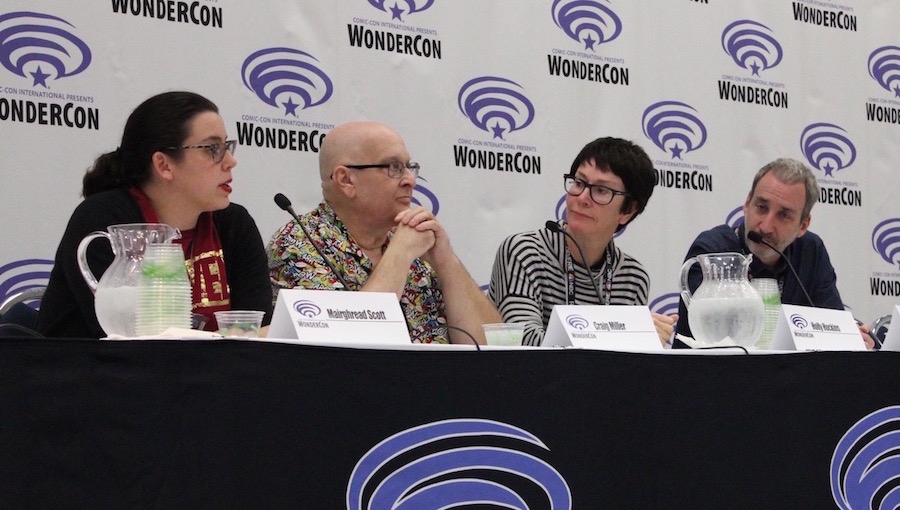Now in its 32nd year, WonderCon returned to the Anaheim Convention Center last Friday, March 23, through Sunday, March 25. Comic-Con International organizers assembled a robust schedule of programming over the three days that entertained, educated, and celebrated fandoms. Late Saturday afternoon, 100+ attendees quieted as moderator Craig Miller (Curious George; Beast Wars) began the “Writing Great Dialogue” panel by introducing his panelists, industry writers Mairghread Scott (Guardians of the Galaxy, Transformers, Rescue Bots), Holly Huckins (Rugrats, Sheriff Callie’s Wild West), and Jim Krieg (Justice League Action, Batman: Gotham by Gaslight).
Once the introductions were completed, Miller asked the panelists to describe what they think about when they write dialogue. Scott led off by stating that each character needs to have their own distinct voice, and in order to make sure that each of hers does, she will read through the dialogue of each character separately. She does this to make sure their voice/speech patterns are consistent and fit the character. Miller agreed, adding that written dialogue doesn’t always work when spoken. Krieg confirmed the importance of reading the dialogue aloud, and Huckins added that this method reveals dialogue that doesn’t work. Additionally, she stated that the writer should be able to mask the characters’ names and be able to identify each character by their dialogue.
Characters should talk to their role, especially support characters, Miller said. Scott said she agreed up to a point; she added that writers should explore their characters’ speech patterns in order to add depth to the characters. Given that all of the writers on the panel write in the animation medium, Miller gave the example that in animation, there isn’t much time to fully develop a character, so their speech patterns help to quickly define the character for the young audience. Krieg agreed that the approach to dialogue and its use will vary depending on the medium. In live action, for example, writers have more time to develop and provide depth to the main characters, so writers don’t have to depend nearly as much on speech patterns as you do when writing for animation. Miller added that comic books require a different approach, too, and Huckins expanded on the comic strips’ approach.
Miller next asked the writers how they determine how a character will speak. Scott said she looks at existing characters in order to find inspiration for her own characters. She provided an example: An assignment for a college writing class required that students jot down conversations overhead. As she rode the subway, she would jot snip-its of conversations. It was an excellent way to experiment with dialogue and develop distinct character speech patterns. Krieg stated that he looks to actors he would want to fill the role. Scott takes quirks and ticks to enrich her characters. Krieg agreed and added that improvisation is a useful tool for creating characters. Miller suggested taking classes that encourage character development, such as improv. Improv, according to Krieg, reveals another aspect of being a writer: sales. This is usually a challenge for writers who are typically introverts. Scott agreed and added that it is scary to sell ideas, but it is helpful to remember that others in the room are probably just as awkward about the selling aspect.
Miller asked for questions from the audience. One person asked the best approach or method for weaving character details into the dialogue. Scott explained there are three levels of dialogue: (1) direct dialogue; (2) dialogue that speaks to a topic tangentially, such as in a tense scene in Die Hard when Hans Gruber tells Takagi that it would be a shame to spoil his suit; and (3) dialogue is not directly connected, such as during the conversation between Hunter and Ramsey as they discuss the color of Lipizzaner stallions in Crimson Tide. It is possible to slip in dialogue during action scenes, such when Black Widow and Hawkeye quickly exchange dialogue that they remember Budapest very differently (Captain America: Civil War).
From the audience, another attendee asked how to handle characters with accents. Huckins stated she tries not to use accents. Miller related that scriptwriters should note the character’s accent, but let the actor interpret the dialogue, rather than write dialogue that is heavily laden with accented speech patterns. Krieg agreed and shared that early in his writing career, he made the mistake of writing out dialogue for Scooby-Doo; the actor let him know it was not necessary to spell out dialogue sounds such as Scooby-Doo’s “ruh-roh.” Scott concurred that a footnote of the character’s accent and/or translation, especially in comics, is a sufficient method. Krieg wisely suggested to go understated.
Another audience member asked how to keep cipher characters from becoming flat. Scott stated to avoid them since they are typically bland. Krieg mentioned that while Jack Reacher (Tom Cruise) may be a bit flat, it is more about the characters around him that are enriched by Reacher’s blandness. Scott added that Chigurh (Javier Bardem) in No Country for Old Men would have been a cipher character, except that he was given ticks that kept him from becoming a flat character.
With the hour almost up, the panelists were asked to weigh in on hiding identity. Krieg said the character’s ability to hid their true identity depended on how good the character is at it. For example, he thought about Monk, who took a comedic tone, while Bruce Wayne/Batman is played with a serious tone. Scott suggested giving the character a tick that cannot be disguised. Miller added looking at the situation that character inhabits. And with that, the panel concluded.
Photo courtesy of Michele Brittany.

